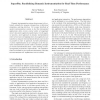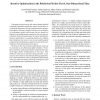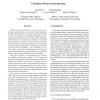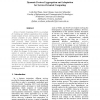CGO
2007
IEEE
14 years 6 months ago
2007
IEEE
This paper proposes the use of empirical modeling techniques for building microarchitecture sensitive models for compiler optimizations. The models we build relate program perform...
CGO
2007
IEEE
14 years 6 months ago
2007
IEEE
Memory transfers are becoming more important to optimize, for both performance and power consumption. With this goal in mind, new register allocation schemes are developed, which ...
CGO
2007
IEEE
14 years 6 months ago
2007
IEEE
The demand for high performance has driven acyclic computation accelerators into extensive use in modern embedded and desktop architectures. Accelerators that are ideal from a sof...
CGO
2007
IEEE
14 years 6 months ago
2007
IEEE
Dynamic instrumentation systems have proven to be extremely valuable for program introspection, architectural simulation, and bug detection. Yet a major drawback of modern instrum...
CGO
2007
IEEE
14 years 6 months ago
2007
IEEE
Emerging microprocessors offer unprecedented parallel computing capabilities and deeper memory hierarchies, increasing the importance of loop transformations in optimizing compile...
CGO
2007
IEEE
14 years 6 months ago
2007
IEEE
Software Dynamic Translation (SDT) systems are used for program instrumentation, dynamic optimization, security, intrusion detection, and many other uses. As noted by many researc...
CGO
2007
IEEE
14 years 6 months ago
2007
IEEE
Modern memory systems play a critical role in the performance of applications, but a detailed understanding of the application behavior in the memory system is not trivial to atta...
CGO
2007
IEEE
14 years 6 months ago
2007
IEEE
The JavaTM programming language does not allow the programmer to influence memory management. An object is usually allocated on the heap and deallocated by the garbage collector ...
ASWEC
2007
IEEE
14 years 6 months ago
2007
IEEE
Service Oriented Computing (SOC) is a paradigm for building new software applications from existing loosely-coupled services. During service composition, services available to pla...
ASWEC
2007
IEEE
14 years 6 months ago
2007
IEEE
Behavior Trees (BTs) are a graphical notation used for formalising functional requirements and have been successfully applied to several case studies. However, the notation curren...





